Biomaterials Research Lab
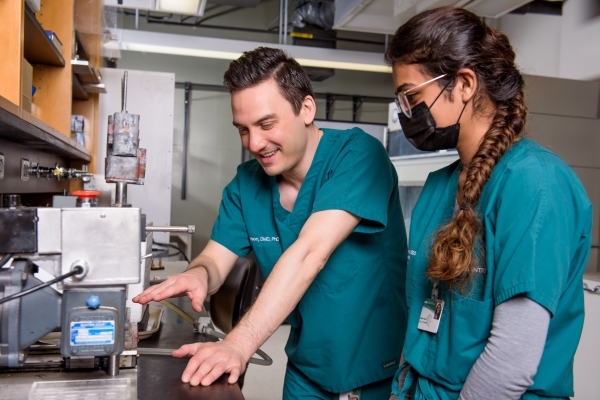
PI Name: Nathaniel Lawson
SOD Research Theme: Biomaterials
Research Focus: We perform mechanical, optical, and some biologic property testing for dental materials. We perform mostly contracted research for dental manufacturers to help in the development process of new products, optimize the performance of dental materials, assist with the creation of instructions for use, and compare new products to existing products.
-
Project Summary
Our lab is devoted to performing mechanical, adhesive, optical, and some biologic property testing for dental materials. We perform mostly contracted research for dental manufacturers to help in the development process of new products, optimize the performance of dental materials, assist with the creation of instructions for use, and compare new products to existing products. Our lab focuses on dental composites, ceramics, adhesives and cements. We can perform a wide variety of tests, some of which are described here:
Mechanical property testing
- Wear (opposing ceramics or enamel)
- Flexural strength (biaxial and 3-point) and fracture toughness
- Crown strength testing
- Depth of cure
- Shrinkage stress
- Hardness
Adhesive property testing
- Shear bond strength
- Crown retention strength
Optical property testing
- Gloss
- Translucency
- Staining / Color stability
Biologic property testing
- Artificial caries model / inhibition of demineralization
- Calcium /fluoride release and recharge
- Hydroxyapetite formation
-
Lab Members
- Nathaniel Lawson, D.M.D., Ph.D. (Associate Professor)
- Thomas Lawson, M.S. (Volunteer Assistant Professor)
- John Burgess, D.D.S., M.S. (Adjunct Professor)
- Chan-Te Huang (Chief Resident)
- Shantanu Mankar (Resident)
- Faimeena Farheen (Volunteer researcher)
-
Publications
- Lawson NC, Jurado CA, Huang CT, Morris GP, Burgess JO, Liu PR, Kinderknecht KE, Lin CP, Givan DA. Effect of Surface Treatment and Cement on Fracture Load of Traditional Zirconia (3Y), Translucent Zirconia (5Y), and Lithium Disilicate Crowns. J Prosthodont. 2019 Jul;28(6):659-665.
- Kwon SJ, Lawson NC, McLaren EE, Nejat AH, Burgess JO. Comparison of the mechanical properties of translucent zirconia and lithium disilicate. J Prosthet Dent. 2018 Jul;120(1):132-137.
- Lawson NC, Bansal R, Burgess JO. Wear, strength, modulus and hardness of CAD/CAM restorative materials. Dent Mater. 2016 Nov;32(11):e275-e283.
-
Support
Industry Funded Support
-
Contact
Nathaniel Lawson, D.M.D., Ph.D.
Associate Professor
SDB 602
This email address is being protected from spambots. You need JavaScript enabled to view it.
(205) 975-8302
Cheon Lab
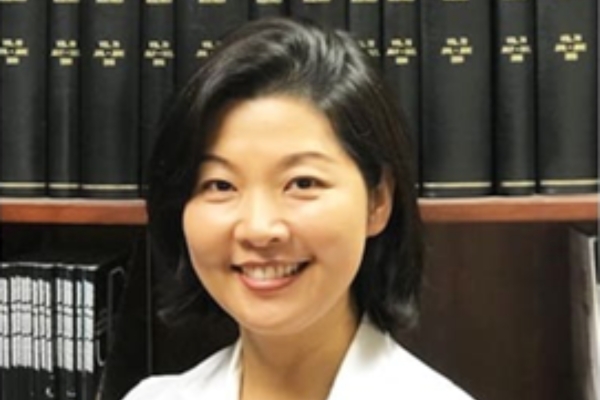
PI Name: Kyounga Cheon D.M.D, M.S.
SOD Research Theme: Biomaterial Science, Biomimetic Tissue Regeneration, and Oral Microbiology
Research Focus: The Cheon Lab focuses on regenerative dental research - to develop a highly innovative injectable nitric oxide releasing biomimetic nanomatrix gel targeting pulp-dentin complex regeneration with an interdisciplinary team collaboration (School of Dentistry, School of Engineering, and industry partners).
-
Project Summary
Project #1: To develop an innovative nitric oxide (NO) releasing biomimetic nanomatrix gel on pulp-dentin revitalization. 1) NO's antibacterial effects with a sustained release pattern from the biomimetic nanomatrix gel. 2) NO’s effect on the dental pulp stem cells (DPSCs) by construction of nature mimicking extra-cellular matrix environment.
Project #2: To develop hydroxyapatite (HA) nanoparticle reinforced peptide amphiphile (PA) based nanomatrix gel. 1) Bioactive effects of organic PAs and reinforcing inorganic HA nanocrystals. 2) Odontogenic and osteogenic differentiation using DPSCs and human mesenchymal stem cells (hMSCs).
Project #3: Streptococcus mutans genotypes were characterized as diversity, commonality, and stability associated with dental caries in a high-caries-risk population using rep-PCR and compared with multilocus sequence typing (MLST) as large-scale epidemiological studies. S. mutans genotyping explained the association of early childhood dental caries through vertical and horizontal transmission.
-
Lab Members
- Dajah Nash, B.S. (Masters Program, Multidisciplinary Biomedical Science)
- Purva Desai, B.D.S. (Graduate Student, MPH, Epidemiology)
- Shreya Hiwalkar, B.D.S. (Masters Program, Multidisciplinary Biomedical Science)
- Philip Le (Undergraduate, BME)
- Akshar Patel (Undergraduate, MBS)
- Noor Judge (Undergraduate, MBS)
-
Publications
- Kim B, Lee YH, Kim IH, Lee KE, Kang CM, Lee HS, Choi HJ, Cheon K, Song JS, Shin Y. Biocompatibility and mineralization potential of new calcium silicate cements. J Dent Sci. 2023 Jul;18(3):1189-1198. doi: 10.1016/j.jds.2022.10.004. Epub 2022 Oct 20. PubMed PMID: 37404639; PubMed Central PMCID: PMC10316440.
- Lin YY, Zhang P, Cheon K, Jackson JG, Lawson NC. Chemical and Physical Properties of Contemporary Pulp Capping Materials. Pediatr Dent. 2022 May 15;44(3):207-212. PubMed PMID: 35799338.
- Kim IH, Jeon M, Cheon K, Kim SH, Jung HS, Shin Y, Kang CM, Kim SO, Choi HJ, Lee HS, Lee KE, Song JS. In Vivo Evaluation of Decellularized Human Tooth Scaffold for Dental Tissue Regeneration. Appl Sci (Basel). 2021 Sep 2;11(18). doi: 10.3390/app11188472. Epub 2021 Sep 13. PubMed PMID: 36003951; PubMed Central PMCID: PMC9397400.
- Yun KH, Ko MJ, Chae YK, Lee K, Nam OH, Lee HS, Cheon K, Choi SC. Doxycycline-Loaded Nitric Oxide-Releasing Nanomatrix Gel in Replanted Rat Molar on Pulp Regeneration. Appl Sci (Basel). 2021 Jul;11(13). doi: 10.3390/app11136041. Epub 2021 Jun 29. PubMed PMID: 36004383; PubMed Central PMCID: PMC9397492.
- Shah D, Lynd T, Ho D, Chen J, Vines J, Jung HD, Kim JH, Zhang P, Wu H, Jun HW, Cheon K.Pulp-Dentin Tissue Healing Response: A Discussion of Current Biomedical Approaches. J Clin Med. 2020 Feb 5;9(2). doi: 10.3390/jcm9020434. PubMed PMID: 32033375; PubMed Central PMCID: PMC7074340.
- Nam OH, Cheon K, Kim MS, Lee HS, Choi SC. Evaluation of the periodontal and pulpal healing of replanted rat molars with doxycycline root conditioning. J Periodontal Implant Sci. 2019 Jun;49(3):148-157. doi: 10.5051/jpis.2019.49.3.148. eCollection 2019 Jun. PubMed PMID: 31285939; PubMed Central PMCID: PMC6599750.
- Chen J, Deng L, Porter C, Alexander G, Patel D, Vines J, Zhang X, Chasteen-Boyd D, Sung HJ, Li YP, Javed A, Gilbert S, Cheon K, Jun HW. Angiogenic and Osteogenic Synergy of Human Mesenchymal Stem Cells and Human Umbilical Vein Endothelial Cells Cocultured on a Nanomatrix. Sci Rep. 2018 Oct 24;8(1):15749. doi: 10.1038/s41598-018-34033-2. PubMed PMID: 30356078; PubMed Central PMCID: PMC6200728.
- Moon CY, Nam OH, Kim M, Lee HS, Kaushik SN, Cruz Walma DA, Jun HW, Cheon K, Choi SC. Effects of the nitric oxide releasing biomimetic nanomatrix gel on pulp-dentin regeneration: Pilot study. PLoS One. 2018;13(10):e0205534. doi: 10.1371/journal.pone.0205534. eCollection 2018. PubMed PMID: 30308037; PubMed Central PMCID: PMC6181396.
- Childers NK, Momeni SS, Whiddon J, Cheon K, Cutter GR, Wiener HW, Ghazal TS, Ruby JD, Moser SA. Association Between Early Childhood Caries and Colonization with Streptococcus mutans Genotypes From Mothers. Pediatr Dent. 2017 Mar 15;39(2):130-135. PubMed PMID: 28390463; PubMed Central PMCID: PMC5385848.
- Kaushik SN, Kim B, Walma AM, Choi SC, Wu H, Mao JJ, Jun HW, Cheon K. Biomimetic microenvironments for regenerative endodontics. Biomater Res. 2016;20:14. doi: 10.1186/s40824-016-0061-7. eCollection 2016. PubMed PMID: 27257508; PubMed Central PMCID: PMC4890532.
- Cheon K, Moser SA, Wiener HW, Whiddon J, Momeni SS, Ruby JD, Cutter GR, Childers NK. Characteristics of Streptococcus mutans genotypes and dental caries in children. Eur J Oral Sci. 2013 Jun;121(3 Pt 1):148-55. doi: 10.1111/eos.12044. Epub 2013 Apr 19. PubMed PMID: 23659236; PubMed Central PMCID: PMC3652634.
- Cheon K, Moser SA, Whiddon J, Osgood RC, Momeni S, Ruby JD, Cutter GR, Allison DB, Childers NK. Genetic diversity of plaque mutans streptococci with rep-PCR. J Dent Res. 2011 Mar;90(3):331-5. doi: 10.1177/0022034510386375. PubMed PMID: 21297016; PubMed Central PMCID: PMC3088998.
-
Support
- Alabama Research and Development Enhancement Fund, 1ARDEF23 02 (2022-2024)
- Alabama Research and Development Enhancement Fund, 1ARDEF22 09 (2021-2024)
- Pilot Grant UAB Global Center for Craniofacial, Oral and Dental Disorder (2019)
- AADOCR Anne D. Haffajee Fellowship (2018),
- National Institute of Dental and Craniofacial Research: K08 DE027401 (2017-2023)
- UAB Faculty Development Grant Program (2014 and 2017)
- National Institute of Dental and Craniofacial Research: L30 DE023672 (2015-2016)
-
Media Releases
-
2023 - Endomimetics™ Announces a Research Collaboration Agreement with BISCO, Inc., to Support Development of a Dental Application of Bionanomatrix™ at GlobeNewswire
-
2023: SOD eNEWS
-
2018: UAB Media Release
-
-
Contact
Kyounga Cheon D.M.D, M.S.
Associate Professor
SDB 802
This email address is being protected from spambots. You need JavaScript enabled to view it.
(205) 975-4303
Cunha-Cruz Lab
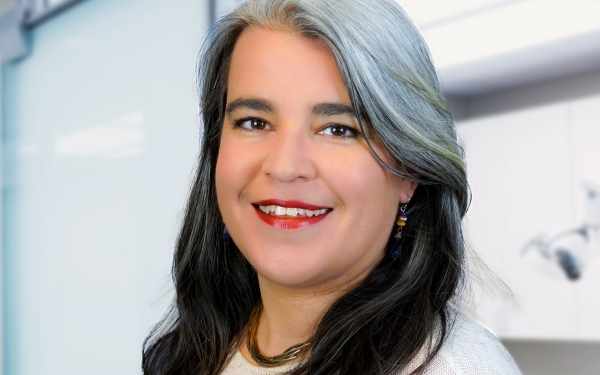
PI Name: Joana Cunha-Cruz, M.P.H., D.D.S., Ph.D.
SOD Research Themes: Clinical Outcomes and Implementation Science, Oral Health Inequities
Research Focus: Dr. Cunha-Cruz research focuses on epidemiological and clinical studies on etiology and management of oral conditions and the development, implementation, and dissemination of strategies to improve dental care delivery systems to reduce disparities.
-
Project Summary
Our lab uses oral epidemiology, behavioral and implementation sciences, and evidence-based practice methods to understand and improve dental practice and systems for better health and health equity.
-
Lab Members
- Latha Sree Rayala, D.D.S., M.S. (Research data coordinator)
-
Publications
- Feedback on audit and action planning for dental caries control: a qualitative study to investigate the acceptability among interdisciplinary pediatric dental care teams. Cunha-Cruz J, Hilgert JB, Harter C, Rothen ML, Hort K, Mallott E.Front Oral Health. 2023 Jun 30;4:1195736. doi: 10.3389/froh.2023.1195736. eCollection 2023. PMID: 37456360.
- Feasibility and acceptability of home delivery of water for dental caries control in Latinx children-"Sediento por una Sonrisa," Thirsty for a Smile: Single-arm feasibility study. Cunha-Cruz J, Ko LK, Mancl L, Rothen ML, Harter C, Hilgert JB, Koday MK, Davis S.Front Public Health. 2022 Sep 20;10:916260. doi: 10.3389/fpubh.2022.916260. eCollection 2022. PMID: 36203695.
- Structure, function, and productivity from the National Dental Practice-Based Research Network. Gilbert GH, Fellows JL, Allareddy V, Cochran DL, Cunha-Cruz J, Gordan VV, McBurnie MA, Meyerowitz C, Mungia R, Rindal DB; National Dental PBRN Collaborative Group.J Clin Transl Sci. 2022 Jun 22;6(1):e87. doi: 10.1017/cts.2022.421. eCollection 2022. PMID: 35989860.
- Medical-Dental Integration in a Rural Community Health Center: A Qualitative Program Evaluation. Pawloski C, Hilgert J, Senturia K, Davis S, Koday M, Cunha-Cruz J.Health Promot Pract. 2022 May;23(3):416-424. doi: 10.1177/15248399211002832. Epub 2021 Apr 14. PMID: 33853397
- Organizational Readiness to Implement System Changes in an Alaskan Tribal Dental Care Organization. Randall CL, Hort K, Huebner CE, Mallott E, Mancl L, Milgrom P, Nelson L, Senturia K, Weiner BJ, Cunha-Cruz J.JDR Clin Trans Res. 2020 Apr;5(2):156-165. doi: 10.1177/2380084419871904. Epub 2019 Sep 9. PMID: 31499017.
-
Support
NIDCR
-
Contact
Joana Cunha-Cruz, M.P.H., D.D.S., Ph.D.
This email address is being protected from spambots. You need JavaScript enabled to view it.
(205) 996-5298
Hassan Lab

PI Name: Quamarul Hassan
SOD Research Theme: Craniofacial Development/Genetics
Research Focus: We are seeking to understand genetic changes that occur during the maturation of the bone building cells, osteoblasts. Specifically, we study the epigenetic controls that drive osteoblast differentiation from their parent stem cell population. We perform these studies in mouse models to identify how epigenetic modulators affect bone density, physiology, and structure.
-
Project Summary
Our lab is devoted to making novel biomedical discoveries that will help to lay the foundation for the next generation of therapeutics to prevent bone loss disorders. We are furthering this goal by seeking to understand genetic changes that occur during the maturation of the bone building cells, osteoblasts. Specifically, we study the epigenetic controls that drive osteoblast differentiation from their parent stem cell population. We perform these studies in mouse models to identify how epigenetic modulators affect bone density, physiology, and structure. Our lab is making these scientific strides along three major projects:
- miR-23a cluster regulation of an epigenetic axis controlling osteoblast differentiation
- The role of BAF45a in BAF chromatin remodeling to epigenetically promote osteogenesis
- Long non-coding RNA Dio3os regulation of thyroid hormone signaling
-
Lab Members
- Quamarul Hassan, D.V.M., Ph.D. (Associate Professor)
- Delores Stacks, Ph.D. (Post Doctoral /Dental Academic Research Trainee - DART)
- Tanner Godfrey (D.M.D./Ph.D. Dual Degree Student/DART Alumni)
- Theodore Busby (Graduate Student/DART Scholar)
- Benjamin Wildman (Graduate Student/DART Alumni)
- Yuechuan Chen, D.D.S. (Visiting Scientist)
-
Publications
- Hassan Q, Chen Y, Wldman BJ, Rehn M, Mishra S. LncRNA Dio3os regulates neighboring gene Dio3 and impacts osteogenesis in trans. bioRxiv [Preprint]. 2025 Apr 14:2025.04.14.647401. PMCID: PMC12047886.
- Akinduro O, Kumar S, Chen Y, Thomas B, Hassan Q, Sims B. Human breast milk-derived exosomes attenuate lipopolysaccharide-induced activation in microglia. J Neuroinflammation. 2025 Feb 15;22(1):41. doi: 10.1186/s12974-025-03345-2., PMCID: PMC11830176.
- Rashid, H.; Sherwani, M.A.; Seo, J.V.; Ahmad, A.; Tasnim, S.; Hassan, Q.; Yusuf, N. K-Homology Splicing Regulatory Protein (KSRP) Augments Survival and Proliferation of Human Melanoma Cells. Curr. Issues Mol. Biol. 2025, 47, 356. https://doi.org/10.3390/cimb47050356, PMC12109896
- Leavenworth JD, Yusuf N, Hassan Q. K-Homology Type Splicing Regulatory Protein: Mechanism of Action in Cancer and Immune Disorders. Crit Rev Eukaryot Gene Expr. 2024;34(1):75-87. doi: 10.1615/CritRevEukaryotGeneExpr.2023048085.
- Busby T, Chen Y, Godfrey TC, Rehan M, Wildman BJ, Smith CM, Hassan Q. Baf45a Mediated Chromatin Remodeling Promotes Transcriptional Activation for Osteogenesis and Odontogenesis. Frontiers in Endocrinology. 2022; 12:763392. PMCID: PMC8762305.
- Singh AK, Haque M, Madarampalli B, Shi Y, Wildman BJ, Basit A, Khuder SA, Prasad B, Hassan Q, Ahmed S, Ouseph MM. Ets-2 Propagates IL-6 Trans-Signaling Mediated Osteoclast-Like Changes in Human Rheumatoid Arthritis Synovial Fibroblast. Front Immunol. 2021; 12:746503. Erratum in: Front Immunol. 2021; 12:808756. PMCID: PMC8593237.
- Godfrey TC, Wildman BJ, Beloti MM, Kemper AG, Ferraz EP, Roy B, Rehan M, Afreen LH, Kim E, Lengner CJ, Hassan Q. The microRNA-23a cluster regulates the developmental HoxA cluster function during osteoblast differentiation. J Biol Chem. 2018 Sep 21. pii: jbc. RA118.003052. doi: 10.1074/jbc. RA118.003052. [Epub ahead of print] PMID: 30242124
- Benjamin J. Wildman, Tanner C. Godfrey, Mohammad Rehan, Yuechuan Chen, Lubana H. Afreen and Quamarul Hassan. MICROmanagement of Runx2 Function in Skeletal Cells. Curr Mol Bio Rep (2019) 5: 55. https://doi.org/10.1007/s40610-019-0115-4.
- Hassan Q. LncRNA, a Noisy or Real Transcriptional Entity? J RNA and Genomics, 2018, Vol 14, 608-609 (Senior and first Author).
- Godfrey TC, Wildman BJ, Javed A and Hassan MQ. 2018. Epigenetic remodeling and modification to preserve skeletogenesis in vivo. Connective Tissue Research. 2018 Dec;59(sup1):52-54. doi: PMID: 29745807
- Heair HM, Kemper AG, Roy B, Lopes HB, Rashid H, Clarke JC, Afreen LK, Ferraz EP, Kim E, Javed A, Beloti MM, MacDougall M, Hassan MQ. MicroRNA 665 Regulates Dentinogenesis through MicroRNA-Mediated Silencing and Epigenetic Mechanisms. Mol Cell Biol. 2015. 35(18):3116-30. PMID: 26124283.
- Hassan MQ, Tye, CE, Stein, GS, Lian, JB., (2015). Non-coding RNAs: Epigenetic regulators of bone development and homeostasis. Bone. 2015 May 31. pii: S8756-3282(15)00207-0. doi: 10.1016/j.bone.2015.05.026. Review. PMID: 26039869 (Senior and first Author)
- Kato RB, Roy B, De Oliveira FS, Ferraz EP, De Oliveira PT, Kemper AG, Hassan MQ (Co-senior author), Rosa AL, Beloti MM. Nanotopography Directs Mesenchymal Stem Cells to Osteoblast Lineage Through Regulation of microRNA-SMAD-BMP-2 Circuit. J Cell Physiol. 2014 Mar 12. doi: 10.1002/jcp.24614. [Epub ahead of print] PMID: 24619927 (Senior author)
- Hassan MQ, Maeda Y, Taipaleenmaki H, Zhang W, Jafferji M, Gordon JA, Li Z, Croce CM, van Wijnen AJ, Stein JL, Stein GS, Lian JB. miR-218 directs a Wnt signaling circuit to promote differentiation of osteoblasts and osteomimicry of metastatic cancer cells. J Biol Chem. 2012 Dec 7; 287(50):42084-92. doi: 10.1074/jbc.M112.377515. Epub 2012 Oct 11. PMID: 23060446.
- Wildman BJ, Godfrey TC, Rehan M, Chen Y, Afreen L, Hassan MQ. MICROmanagement of Runx2 Function in Skeletal Cells. Current Molecular Biology Reports. 2019; 5(1): 55-64.
- Godfrey TC, Wildman BJ, Beloti MM, Kemper AG, Ferraz EP, Roy B, Rehan M, Afreen LH, Kim E, Lengner CJ, Hassan MQ. MiR-23a cluster regulates HoxA cluster function during osteoblast differentiation. Journal of Biological Chemistry. 2018; 293(45):17646-17660, PMID: 30242124.
- Godfrey T, Wildman BJ, Javed A, Lengner CJ, Hassan MQ. (2017) Epigenetic remodeling and modification to preserve skeletogenesis in vivo, Connective Tissue Research. 2017; 59(sup1): 52-54. PMID: 29745807.
-
Resources
- miR-23a cluster zip inducible knockdown mouse model
- Baf45a deletion mouse model
- EZH2 deletion mouse model
-
Support
Grant Number: 1R01AR069578 (2017-2021)
Funding Source: NIH/National Institute of Arthritis and Musculoskeletal and Skin Diseases
Dr. Quamarul Hassan: Principal Investigator
Project Title: An Epigenetic Axis in Bone FormationAward Number: T90DE022736 (Training Grant)
Funding Source: National Institute of Dental and Craniofacial Research/NIH/DHHS
Project Title: Dental Academic Research Training Program (DART)
Project Period: (2017-2022)
Dr. Quamarul Hassan: Co-DirectorGrant Number: 1 F30 DE027280-01A1
Principal Investigator: Godfrey, Tanner Cole
Project Title: The Role of Baf45a in Bone Formation
Funding Source: National Institute of Dental and Craniofacial Research/NIH/DHHS
Award Issue Date: 04/30/2018
Dr. Quamarul Hassan: Mentor and SponsorAward Number: AR072615-01A1
Funding source: NIH/NIAID
Title: MicroRNA-based therapy for rheumatoid arthritis
This project is to translate the potential of miR-17 as therapeutic RNA for Rheumatoid Arthritis.
Project Period: 09/15/2018 – 08/31/2023
Dr. Quamarul Hassan: Co-investigator -
Contact
Quamarul Hassan, Ph.D.
Professor
SDB 707
This email address is being protected from spambots. You need JavaScript enabled to view it.
(205) 975-3020
Javed Lab

PI Name: Amjad Javed
SOD Research Theme: Craniofacial Genetics and development, Biomaterial and Biomimetic
Research Focus: The central focus of our laboratory is to understand the molecular mechanisms that govern the formation and remodeling of skeletal tissues such as Cartilage, Bone, Teeth, and Tendon. Skeletal cell differentiation involves the stepwise establishment of specific genetic programs in mesenchymal stem cells. We are exploring the signaling role of runt related transcription factor (Runx), and Specificity protein 7 (Sp7) in the coordinated regulation of various mesenchymal cell types such as Chondrocyte, Osteoblast, Osteocyte, Odontoblast, and Adipocytes.
-
Research Focus Continued
Throughout our life, bone is constantly renewed via a two-part process called remodeling. This process consists of bone resorption and bone formation. During resorption, old bone tissue is broken down and removed by special cells called osteoclasts. During bone formation, new bone tissue is laid down to replace the old. This task is performed by special cells called osteoblasts. Osteoclast and osteoblast function is regulated by several genes, growth factors and cytokines and hormones such as calcitonin, parathyroid hormone, vitamin D, estrogen and testosterone. Runx2 protein is required for normal differentiation and hormonal responsiveness of the osteoblasts. Our lab utilizes biochemical, cellular, genetic and molecular approaches to identify molecular pathways that convey the osteogenic signal to nuclear transcription factors for the formation and activity of bone cells.
Global deletion of Runx2 and Sp7 gene results in a complete absence of bone formation and null mice die either in utero or shortly after birth. To circumvent early lethality, we have developed mouse models where these genes can be inactivated in a spatiotemporal fashion. Our efforts are directed to understand the cell-specific roles of these genes during postnatal bone formation and remodeling, fracture healing, osteoporosis, and aging. We are also investigating the molecular and cellular basis of skeletal abnormalities in human Cleidocranial dysplasia, lipodystrophy and mineral homeostasis.
-
Project Summary
Runx2 Regulated Osteoblast Signaling for Marrow Adipogenesis and Energy Homeostasis: Patients with metabolic diseases, such as obesity, diabetes, and lipodystrophy exhibits altered bone and fat mass, fat distribution and energy homeostasis. The underlying mechanisms involved in these dysregulations are poorly understood. We aim to identify molecular mechanisms underlying the metabolic diseases with comorbidity of the bone and fat, especially novel factors secreted by the bone synthesizing osteoblast that can regulate bone marrow adipogenesis, peripheral fat distribution, and energy homeostasis.
Craniofacial Development and Dysmorphogenesis: Tooth development in mammals requires a series of complex interactions between odontogenic epithelium and mesenchyme of the early jaw primordia. The molecular interactions required to generate teeth are mediated by signaling molecules, and transcription factors to specify gene expression. Runx2 is an essential transcription factor for lineage commitment and differentiation of skeletal and dental cells. In humans, mutations in the Runx2 and Sp7 gene are associated with Cleidocranial dysplasia (CCD), and Osteogenesis Imperfecta (OI), respectively. We utilize the conditional gene knock-out mouse model to study regulatory control for initiation and developmental progression of tooth organ and unique gene circuitry supporting the development and formation of supernumerary teeth.
Molecular Regulation of Synthesis and Degeneration of Cartilage: Multiple skeletal disorders in humans result from the perturbation of the balance between proliferation and hypertrophic maturation of chondrocytes within the growth plate. These include chondrodysplasias, Beckwith-Wiedemann syndrome, dwarfisms, and neoplasms affecting cartilage and bone. Impairments in musculoskeletal joint function are among the most prevalent degenerative disease and the leading causes of morbidity and significant disability worldwide. However, the mechanisms leading to an imbalance between chondrocyte proliferation and hypertrophic maturation remain unknown. We are utilizing cartilage-specific models to uncover molecular signals regulating the fate of hypertrophic chondrocyte in postnatal cartilage synthesis during normal development and how it is deregulated in disease.
-
Lab Members
- Harunur Rashid, Ph.D. (Postdoctoral Fellow)
- Deepa Gadde (Undergraduate Research Student)
- Nimra Khan (Undergraduate Research Student)
- Saisha Awasthi (Undergraduate Research Student)
- Vashti Convers (Undergraduate Research Student)
- Zahab Aleezada (Undergraduate Research Student)
-
Publications
- Khass M, Rashid H, Burrows PD, Bridges SL Jr, Javed A, Schroeder HW Jr. “Disruption of the preB cell receptor complex leads to decreased bone mass”. Front Immunol. 2019. PMCID: PMC6736987
- Chen J, Deng L, Porter C, Alexander G, Patel D, Vines J, Zhang X, Chasteen-Boyd D, Sung HJ, Li YP, Javed A, Gilbert S, Cheon K, Jun HW. “Angiogenic and osteogenic synergy of human mesenchymal stem cells and human umbilical vein endothelial cells co-cultured on a nanomatrix”. Sci Rep. 2018. PMCID: PMC6200728
- Bae JM, Clarke JC, Rashid H, Adhami MD, McCullough K, Scott JS, Chen H, Sinha KM, de Crombrugghe B, Javed A. “Specificity protein 7 is required for proliferation and differentiation of ameloblasts and odontoblasts”. J Bone Miner Res. 2018. PMCID: PMC6002875
- Rashid H, Chen H, Hassan Q, Javed A. “Dwarfism in homozygous Agc1CreERT mice is associated with decreased expression of aggrecan”. Genesis. 2017. PMCID: PMC5648336
- Trotter TN, Li M, Pan Q, Peker D, Rowan PD, Li J, Zhan F, Suva LJ, Javed A, Yang Y. “Myeloma cell-derived Runx2 promotes myeloma progression in bone”. Blood. 2015. PMCID: PMC4458799
- Adhami MD, Rashid H, Chen H, Javed A. “Runx2 activity in committed osteoblasts is not essential for embryonic skeletogenesis”. Connect Tissue Res. 2014. PMCID: PMC4269215
- Clarke JC, Bae JM, Adhami M, Rashid H, Chen H, Napierala D, Gutierrez SE, Sinha K, de Crombrugghe B, Javed A. “Specificity protein 7 is not essential for tooth morphogenesis”. Connect Tissue Res. 2014. PMCID: PMC4269224
- Rashid H, Ma C, Chen H, Wang H, Hassan MQ, Sinha K, de Crombrugghe B, Javed A. “Sp7 and Runx2 molecular complex synergistically regulate expression of target genes”. Connect Tissue Res. 2014. PMCID: PMC4269247
- Adhami MD, Rashid H, Chen H, Clarke JC, Yang Y, Javed A. “Loss of Runx2 in committed osteoblasts impairs postnatal skeletogenesis”. J Bone Miner Res. 2015. PMCID: PMC4280286
- Chen H, Ghori-Javed FY, Rashid H, Adhami MD, Serra R, Gutierrez SE, Javed A. “Runx2 regulates endochondral ossification through control of chondrocyte proliferation and differentiation”. J Bone Miner Res. 2014. PMCID: PMC4535340
-
Support
- National Institute of Arthritis and Musculoskeletal and Skin Diseases (NIAMS)
- National Institute of Dental and Craniofacial Research (NIDCR)
- National Institute on Aging (NIA)
-
Contact
Amjad Javed, M.Sc., Ph.D.
Professor and Director Postgraduate Education
Associate Dean for Research
SDB 714
This email address is being protected from spambots. You need JavaScript enabled to view it.
(205) 996-5124
Lamani Lab
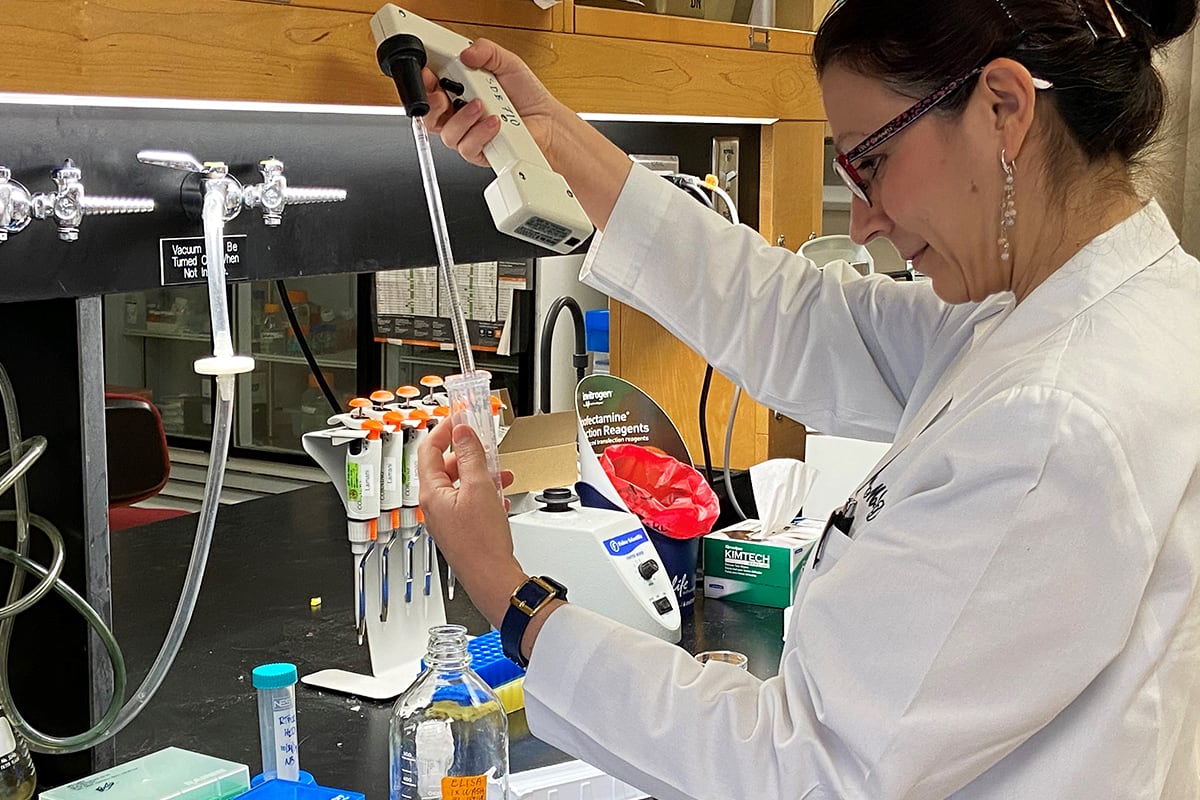
PI Name: Ejvis Lamani
SOD Research Theme: Craniofacial Development/Genetics
Research Focus: Dr. Lamani is a clinician scientist with advance training in Orthodontics specializing in craniofacial growth and development. Her interest lies on craniofacial biology and genetics with emphasis on dental development and related human genetic disorders. Her research aim is to translate the molecular biology and genetics of human growth and development to the treatment and future prevention of craniofacial and dental anomalies.
-
Project Summary
Dr. Lamani’s team is working on understanding the pathology and clinical management of disorders such as Short Root Anomaly, External Apical Root Resorption, and Hypodontia. She is also involved in studies of TMJ function and disorders.
-
Lab Members
- Ejvis Lamani, D.M.D., Ph.D. (Assistant Professor)
- Frank Litchfield, D.M.D. (Graduate Student)
- Giana Lupinetti, D.M.D. (Graduate Student)
- Najd Aswad, B.D.S. (Graduate Student)
- Balraj Bains, B.D.S. (Graduate Student)
- Nellie Bahaei (Undergraduate Student)
- Kayla Holcombe (Undergraduate Student)
-
Contact
Ejvis Lamani, D.M.D., Ph.D.
Assistant Professor
SDB 313This email address is being protected from spambots. You need JavaScript enabled to view it.
(205) 934-3251
Zhang Lab
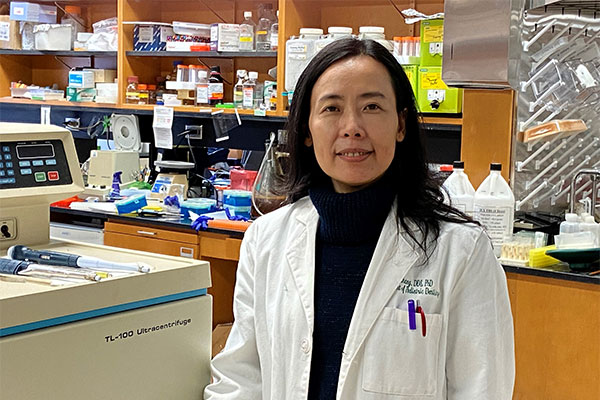
PI Name: Ping Zhang
SOD Research Theme: Oral Microbiology, Infection/Host Response
Research Focus: The Zhang Lab focuses on studying the host-microbial interactions in the pathogenesis of oral infectious diseases, with a specific interest in understanding the signaling mechanisms involved in the regulation of inflammation and bone loss in the context of infection with periodontal pathogens.
-
Project Summary
Our primary research interests are to understand the host-microbial interactions in the pathogenesis of periodontitis. We are particularly interested in understanding how the innate signaling pathways regulate inflammation and bone loss, and the complex signaling crosstalk between inflammation and osteoclastogeneiss. We are also interested in understanding the regulation of osteoclast precursors during chronic infection, and the role of osteoclast precursors in regulating host immune response and bone loss.
Increasing evidence suggests that periodontitis contributes to the development of Alzheimer’s disease. Our group is also interested in understanding if there is a cause-effect relationship between periodontal infection and the development of AD-associated neuropathology, and if so, what are the underlying mechanisms.
In addition, with a team of collaborators, we have been working on the development and characterization of various adjuvants and antigen delivery systems in potentiating immune responses to microbial antigens. Studies also involve identification of immunologic molecules and downstream signaling pathways in regulating the host immune responses to subunit mucosal vaccines against oral microbial pathogens.
-
Lab Members
- Greg Harber, M.S. (Lab manager)
- Zhaofei Li, D.D.S., Ph.D. (Postdoc /Dental Academic Research Trainee - DART)
- Yanfang Zhao, D.D.S., Ph.D. (Postdoc)
- Xiaoxiao Hao, M.D., Ph.D. (Postdoc)
-
Publications
- Chen Z, Su L, Xu Q, Katz J, Michalek M, Fan M, Feng X, and Zhang P. IL-1R/TLR through MyD88 divergently modulates osteoclastogenesis through regulation of nuclear factor T cells C1 (NFATc1) and B lymphocyte-induced maturation protein-1 (Blimp1). J Biol Chem. 2015;290:30163-30174
- Yang Y, Li Y, Lin Y, Du M, Zhang P, and Fan M. Comparison of immunological and microbiological characteristics in children and the elderly with or without dental caries. Eur J Oral Sci. 2015;123:80-87. PMID:25702606
- Chen L, Qin B, Du M, Zhong H, Xu Q, Li Y, Zhang P, and Fan M. Extensive description and comparison of human supra-gingival microbiome in root caries and health. PLOS One.2015;10:e0117064.PMID: 25658087
- Xu Q, Li ZF, Zhang P, Cao LH, and Fan MW. Effects of 1,25-dihydroxyvitamin D3 on Macrophage cytokine secretion stimulated by Porphyromonas gingivalis. Jpn J Infec Dis. 2016;69:482-487. PMID: 27000452
- Wang P, Devalankar DA, Dai Q, Zhang P and Michalek SM. Synthesis and evaluation of QS-21-based immunoadjuvants with a terminal-functionalized side chain incorporated in the west wing Trisaccharide. J Org Chem. 2016;81:9560-9566. PMID: 27709937
- Su L, Xu Q, Zhang P, Michalek SM, Katz J. The phenotype and function of myeloid-derived suppressor cells induced by Prophyromonas gingivalis infection. Infection and Immunity. 2017;85:e00213-17. PMID: 28533469
- Liang S, Ren H, Guo H, Xing W, Liu C, Ji Y, Jiang H, Zhang P, and Du M. Periodontal infection with Prophyromonas gingivalis induces preterm birth and lower birth weight in rats. Mol Oral Microbiol. 2018;33:312-321. PMID: 29754448
- Guo H, Ren H, Liang S, Ji Y, Jiang H, Zhang P, and Du M. Phosphatidylinositol 3-kinase/Akt signal pathway resists the apoptosis and inflammation in human extravillous trophoblasts induced by Porphyromonas gingivalis. Mol Immunol. 2018;104:100-107. PMID: 30448607
- Wang P, Skalamera D, Sui X, Zhang P, and Michalek SM. Synthesis and evaluation of a QS-17/18-based vaccine adjuvant. J Med Chem. 2019;62:1669-1676. PMID:30656932
- Wang P, Skalamera D, Sui X, Zhang P, and Michalek SM. Synthesis and evaluation of QS-7-based vaccine adjuvants. ACS Infec Dis. 2019;5:974-981. PMID:30920199
- Li Y, Shi Z, Jules J, Chen S, Kesterson RA, Zhao D, Zhang P, and Feng X. Specific RANK cytoplasmic motifs drive osteoclastogenesis. J Bone Miner Res. 2019;34:1938-1951. PMID 31173390
- Wang P, Ding X, Kim H, Skalamera D, Michalek SM, and Zhang P. Vaccine adjuvants derivatized from Momordica saponins I and II. J Med Chem. 2019; Epub ahead of print. PMID: 31657920
-
Support
National Institute of Dental and Craniofacial Research: R01DE026465
National Institute of General Medical Sciences: R01GM120159
National Institute of Dental and Craniofacial Research: R90DE022736
-
Contact
Ping Zhang, D.D.S., Ph.D.
Professor
SDB 804
This email address is being protected from spambots. You need JavaScript enabled to view it.
(205) 996-9803